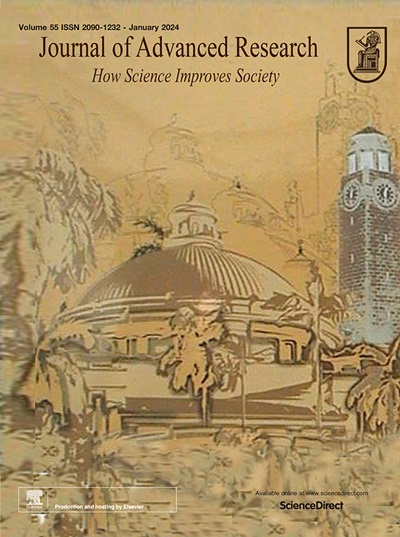NSP6调节钙超载诱导的自噬细胞死亡,并受klhl22介导的泛素化调节
IF 11.4
1区 综合性期刊
Q1 MULTIDISCIPLINARY SCIENCES
引用次数: 0
摘要
严重急性呼吸综合征冠状病毒2 (SARS-CoV-2)对全球构成重大威胁。SARS-CoV-2非结构蛋白(NSPs)对于阻碍宿主复制机制至关重要,同时也有助于新病毒成分的产生和组织。然而,NSPs不被病毒颗粒所吸收,它们在宿主细胞内的后续命运仍然知之甚少。此外,它们在病毒发病机制中的作用需要进一步研究。目的研究NSP6在宿主细胞中的最终归宿,阐明其在病毒发病机制中的作用。方法研究NSP6对细胞死亡的影响并探讨其作用机制;此外,我们还研究了NSP6在人细胞中的降解机制,并分析了其与患者外周血单核细胞(PBMCs)中冠状病毒病2019 (COVID-19)严重程度的相关性。结果snsp6具有诱导细胞死亡的作用。具体来说,NSP6与EI24自噬相关跨膜蛋白(EI24)相互作用,增加细胞内Ca2+水平,从而增强unc-51样自噬激活激酶1 (ULK1)和RB1诱导线圈1 (RB1CC1/FIP200),以及beclin 1 (BECN1)和磷脂酰肌醇3-激酶催化亚基3 (PIK3C3)之间的相互作用。这种级联反应最终引发自噬,从而导致细胞死亡。此外,我们发现NSP6蛋白的稳态受k48连锁泛素化的调控。我们发现kelch样蛋白22 (KLHL22)是E3连接酶,负责泛素化和降解NSP6,恢复细胞内钙稳态和逆转NSP6诱导的自噬细胞死亡。此外,NSP6的表达水平与sars - cov -2诱导疾病的严重程度呈正相关。本研究揭示了klhl22介导的泛素化控制NSP6的稳定性,NSP6通过钙超载诱导自噬细胞死亡,突出了其细胞毒性作用,并提出了靶向钙信号或促进NSP6降解的治疗策略作为对抗COVID-19的潜在干预措施。本文章由计算机程序翻译,如有差异,请以英文原文为准。

NSP6 regulates calcium overload-induced autophagic cell death and is regulated by KLHL22-mediated ubiquitination
Introduction
Severe acute respiratory syndrome coronavirus 2 (SARS-CoV-2) poses a substantial global threat. SARS-CoV-2 nonstructural proteins (NSPs) are essential for impeding the host replication mechanism while also assisting in the production and organization of new viral components. However, NSPs are not incorporated into viral particles, and their subsequent fate within host cells remains poorly understood. Additionally, their role in viral pathogenesis requires further investigation.Objectives
This study aimed to discover the ultimate fate of NSP6 in host cells and to elucidate its role in viral pathogenesis.Methods
We investigated the effects of NSP6 on cell death and explored the underlying mechanism; moreover, we examined the degradation mechanism of NSP6 in human cells, along with analysing its correlation with coronavirus disease 2019 (COVID-19) severity in patient peripheral blood mononuclear cells (PBMCs).Results
NSP6 was demonstrated to induce cell death. Specifically, NSP6 interacted with EI24 autophagy-associated transmembrane protein (EI24) to increase intracellular Ca2+ levels, thereby enhancing the interactions between unc-51-like autophagy activating kinase 1 (ULK1) and RB1 inducible coiled-coil 1 (RB1CC1/FIP200), as well as beclin 1 (BECN1) and phosphatidylinositol 3-kinase catalytic subunit type 3 (PIK3C3). This cascade ultimately triggers autophagy, thus resulting in cell death. Additionally, we discovered that the homeostasis of the NSP6 protein was regulated by K48-linked ubiquitination. We identified kelch-like protein 22 (KLHL22) as the E3 ligase that was responsible for ubiquitinating and degrading NSP6, restoring intracellular calcium homeostasis and reversing NSP6-induced autophagic cell death. Moreover, NSP6 expression levels were observed to be positively associated with the severity of SARS-CoV-2-induced disease.Conclusion
This study reveals that KLHL22-mediated ubiquitination controls NSP6 stability and that NSP6 induces autophagic cell death via calcium overload, highlighting its cytotoxic role and suggesting therapeutic strategies that target calcium signaling or promote NSP6 degradation as potential interventions against COVID-19.求助全文
通过发布文献求助,成功后即可免费获取论文全文。
去求助
来源期刊

Journal of Advanced Research
Multidisciplinary-Multidisciplinary
CiteScore
21.60
自引率
0.90%
发文量
280
审稿时长
12 weeks
期刊介绍:
Journal of Advanced Research (J. Adv. Res.) is an applied/natural sciences, peer-reviewed journal that focuses on interdisciplinary research. The journal aims to contribute to applied research and knowledge worldwide through the publication of original and high-quality research articles in the fields of Medicine, Pharmaceutical Sciences, Dentistry, Physical Therapy, Veterinary Medicine, and Basic and Biological Sciences.
The following abstracting and indexing services cover the Journal of Advanced Research: PubMed/Medline, Essential Science Indicators, Web of Science, Scopus, PubMed Central, PubMed, Science Citation Index Expanded, Directory of Open Access Journals (DOAJ), and INSPEC.
 求助内容:
求助内容: 应助结果提醒方式:
应助结果提醒方式:


